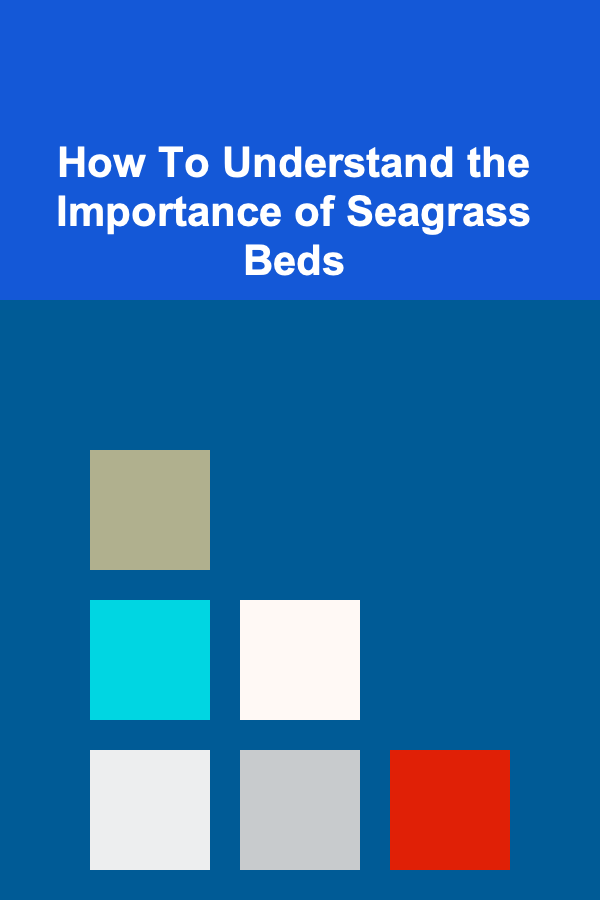
How To Understand the Importance of Seagrass Beds
ebook include PDF & Audio bundle (Micro Guide)
$12.99$8.99
Limited Time Offer! Order within the next:

Seagrass beds are one of the most vital and yet often overlooked ecosystems in the world. They exist beneath the ocean's surface, often out of sight to the average observer, yet their significance cannot be overstated. Seagrass meadows, consisting of flowering plants that thrive in shallow coastal waters, are among the most productive ecosystems on Earth, providing critical services for marine and human life. Understanding the importance of seagrass beds requires examining their ecological roles, their influence on biodiversity, their impact on carbon sequestration, and the threats they face from human activities.
What Are Seagrass Beds?
Seagrass beds are underwater ecosystems formed by dense growths of seagrass, a type of flowering plant that grows in shallow, salty, and brackish coastal waters. Unlike seaweeds, which are algae, seagrasses are true plants that reproduce through flowers and seeds. These plants are often found in areas with soft sediments such as sand or mud, and they can form extensive meadows that stretch across vast areas of the ocean floor.
There are over 60 species of seagrasses found in various coastal regions around the world. Some of the most well-known species include Zostera marina (eelgrass), Posidonia oceanica (a Mediterranean species), and Thalassia testudinum (turtle grass). Seagrasses are often confused with seaweeds, but the key difference lies in their biological classification. Seagrasses are true plants, meaning they have roots, stems, and leaves, and they rely on sunlight for photosynthesis.
The Ecological Importance of Seagrass Beds
Seagrass beds offer an array of ecosystem services that benefit marine life, coastal communities, and the global climate system. These ecosystems are among the most productive on Earth, comparable to tropical rainforests and wetlands, providing critical habitat for countless species, regulating carbon levels, and protecting coastlines.
1. Habitat for Biodiversity
Seagrass meadows support a tremendous diversity of marine species. They act as nursery grounds for many fish and invertebrate species, providing shelter, food, and protection from predators during their early stages of life. Juvenile fish, such as grouper, snapper, and several species of flatfish, find refuge in seagrass beds until they are large enough to venture into deeper waters. Invertebrates like shrimp, crabs, and snails also thrive in these environments, feeding on detritus and microorganisms that live within the seagrass.
Moreover, seagrass beds offer a home to many endangered or threatened species. Green sea turtles (Chelonia mydas ) and manatees (Trichechus ) feed on seagrass, and the meadows provide a safe haven for these animals, as well as a vital source of food. Dugongs (Dugong dugon), closely related to manatees, are another example of marine mammals that rely on seagrass beds for sustenance. The presence of these species highlights the critical role that seagrass beds play in maintaining biodiversity in marine ecosystems.
2. Carbon Sequestration and Climate Regulation
Seagrass meadows are powerful carbon sinks, meaning they capture and store carbon from the atmosphere. This process, known as blue carbon sequestration, is essential in the fight against climate change. Seagrasses absorb carbon dioxide through photosynthesis, and the organic material produced by the plants is then stored in the sediment below, often for centuries or longer. In fact, seagrass meadows are estimated to sequester carbon at a rate up to 35 times faster than tropical rainforests.
The ability of seagrasses to trap carbon helps mitigate the effects of rising atmospheric CO2 levels, which contribute to global warming. In addition to trapping carbon in the soil, seagrass meadows also influence the water quality of coastal regions by reducing carbon in the water column. This makes seagrass beds an invaluable tool in combating climate change and protecting the health of the planet.
3. Coastal Protection
Seagrass beds also play a crucial role in stabilizing coastlines. Their root systems bind sediments together, reducing erosion and protecting coastal areas from the impact of storms and rising sea levels. In areas where seagrass meadows are abundant, the underwater grasses act as natural buffers, absorbing wave energy and preventing the destruction of coastal ecosystems and infrastructure.
During storms, seagrass beds can reduce wave height by as much as 60%, which significantly reduces the potential for damage to coastal properties. In some regions, seagrass meadows are even used as part of natural coastal defense strategies, helping to safeguard coastal communities from flooding and storm surge. As sea levels rise due to climate change, seagrass meadows will become even more important in mitigating the effects of coastal erosion.
4. Water Quality Improvement
Seagrass meadows also play an essential role in improving water quality. By filtering the water, they help remove excess nutrients, pollutants, and sediment, which can otherwise lead to harmful algal blooms, hypoxia (low oxygen levels), and other water quality issues. Seagrasses absorb nutrients such as nitrogen and phosphorus, preventing these substances from accumulating in coastal waters and leading to eutrophication, a process that can deplete oxygen and harm marine life.
Furthermore, seagrass meadows reduce sediment resuspension, which can muddy the water and decrease the amount of light that penetrates the ocean, ultimately impacting the growth of other marine plants. In this way, seagrass meadows contribute to maintaining the overall health of coastal ecosystems by promoting clear, nutrient-balanced waters.
The Threats to Seagrass Beds
Despite their many benefits, seagrass beds are under significant threat from human activities. These ecosystems are fragile, and their decline can have serious consequences for marine life and the environment. There are several key factors that contribute to the degradation of seagrass meadows:
1. Coastal Development
Urbanization and coastal development, including the construction of ports, marinas, and resorts, are among the primary drivers of seagrass loss. The destruction of coastal habitats, including the dredging of seagrass meadows for infrastructure projects, can lead to the direct loss of seagrass beds. Additionally, increased pollution from urban runoff, including chemicals, sewage, and heavy metals, can negatively affect water quality and make it difficult for seagrasses to thrive.
2. Climate Change
Climate change presents a significant threat to seagrass meadows in multiple ways. Rising sea temperatures can cause seagrass to suffer from stress, making them more susceptible to diseases and algae overgrowth. Additionally, ocean acidification, driven by increased carbon dioxide in the atmosphere, can interfere with the ability of seagrasses to grow and develop healthy root systems.
The rise in sea levels also poses a direct threat to seagrass beds, especially those in shallow coastal areas. As sea levels rise, seagrasses may become submerged or exposed to higher temperatures, reducing their capacity to survive and grow.
3. Overfishing and Pollution
Overfishing and unsustainable fishing practices, such as bottom trawling, can cause physical damage to seagrass beds. Trawling involves dragging heavy nets along the ocean floor, which can uproot seagrass and disturb the delicate ecosystem. In addition to physical damage, the use of harmful chemicals and pesticides in agricultural practices can runoff into the ocean, further degrading seagrass habitats and harming the plants.
4. Invasive Species
Invasive species, particularly non-native species of algae, can outcompete seagrass for nutrients and light, leading to the decline of seagrass meadows. For example, the invasive algae Caulerpa taxifolia has been known to take over seagrass beds in certain regions, pushing out native species and disrupting the ecosystem.
Conservation and Restoration Efforts
Recognizing the importance of seagrass beds has led to a growing global effort to conserve and restore these critical ecosystems. Conservation initiatives focus on protecting existing seagrass meadows, while restoration projects aim to revive degraded areas through the planting of seagrass and the mitigation of threats like pollution and overfishing.
Some of the most promising restoration efforts involve transplanting seagrass seedlings into degraded areas, as well as reducing the human impacts that lead to the destruction of seagrass habitats. Additionally, creating marine protected areas (MPAs) and regulating activities like fishing and coastal development can help safeguard seagrass meadows from further degradation.
Conclusion
Seagrass beds are vital ecosystems that provide essential services to marine life, coastal communities, and the global climate. From supporting biodiversity to sequestering carbon, protecting coastlines, and improving water quality, these underwater meadows play a crucial role in maintaining the health of our oceans and our planet. However, seagrasses are under threat from a variety of human-induced pressures, including coastal development, climate change, and pollution.
Understanding the importance of seagrass beds is key to protecting them for future generations. Through concerted conservation and restoration efforts, we can ensure that seagrass meadows continue to thrive, supporting marine life and helping to combat climate change in the process. The preservation of these valuable ecosystems is not only essential for biodiversity but also for the long-term health and sustainability of our oceans and coastal environments.

How to Save on Home Maintenance Costs Year-Round
Read More
Strategic Recruitment: Tactics and Techniques for Finding Top Talent
Read More
How to Use Gestures Naturally
Read More
How To Incorporate Vintage Pieces into Modern Outfits
Read More
How to Explore Quantum Computing for Logistics and Supply Chain
Read More
How to Handle PTSD as a Firefighter
Read MoreOther Products

How to Save on Home Maintenance Costs Year-Round
Read More
Strategic Recruitment: Tactics and Techniques for Finding Top Talent
Read More
How to Use Gestures Naturally
Read More
How To Incorporate Vintage Pieces into Modern Outfits
Read More
How to Explore Quantum Computing for Logistics and Supply Chain
Read More